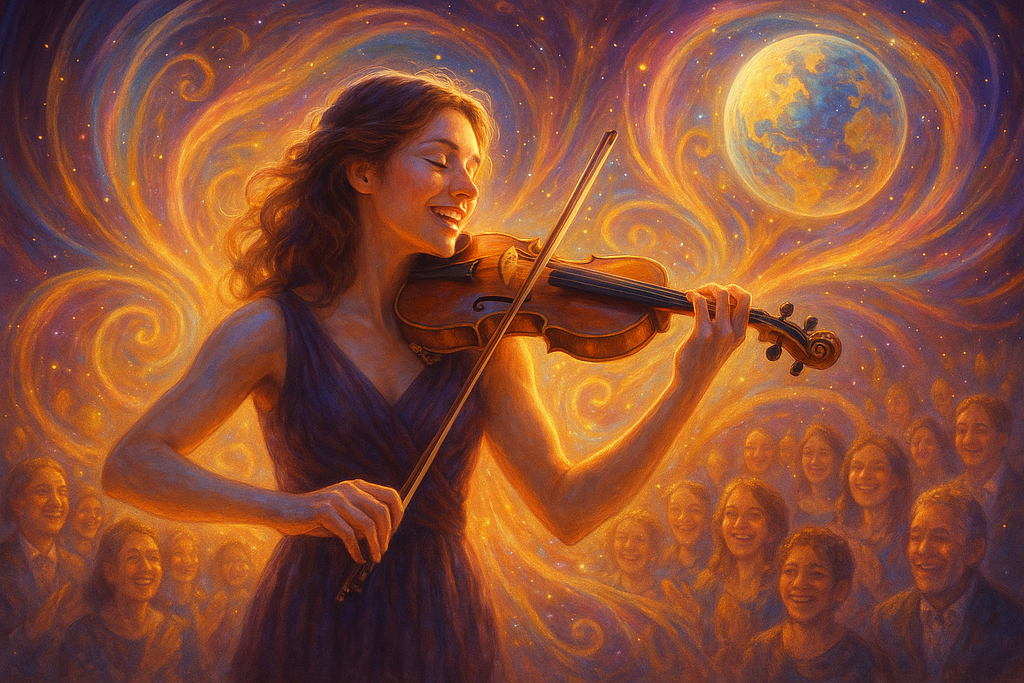
Healing the Inner Critic
“When you get curious about a part, you naturally gain clarity regarding what it’s all about, which typically results in a newfound compassion for all it’s been through and is trying to do.”
— Richard Schwartz, Internal Family Systems
One of the most common questions I get when teaching people about the “inner audience member” is how it differs from the inner critic. For some, the inner critic has such a powerful presence in their inner world that it can seem to drown out their inner audience member. When this is the case, the sheer intensity of the negative messages coming from the inner critic can make it hard to connect with the more life-giving qualities of the inner audience member.
The first thing to know is that your inner critic is not the same thing as your inner audience member. Your inner critic is an aspect of your conditioned expressivity, being an emotional wound that you internalized from others early in life. When your inner critic is active, your creative process becomes more a compensation for the pain within than an expression of your creative aliveness. You may find yourself prioritizing other people’s creative ideas and approaches over what feels true for you. In contrast, your inner audience member is the source of authentic creativity. Creating with your inner audience member in the lead allows you to regard other people’s ideas as potentially useful suggestions in a process that results in an ever-deeper connection with your innate truths and desires. You know you’re letting your inner critic lead when creating leaves you feeling anxious, tense, and small. In contrast, you know you’re letting your inner audience member lead when creating leaves you feeling fulfilled, at ease, and expanded.
Your inner critic is an aspect of your default expressivity, being an emotional wound that you internalized from others early in life. It is not the same thing as your inner audience member.
An overdeveloped inner critic comes into being through repeated exposure to situations where you, during important moments in your youth, were harshly criticized to the point where you were afraid for your well-being. This is a survival situation that stimulates the imperative to regain a sense of self-worth and connection with the tribe – even if that means seeking connection with the ones who just criticized you. Your inner critic forms when, instead of rightly seeing that you don’t deserve such treatment, you blame yourself for having caused such a painful interaction. This new habit of self-blame is what becomes the inner critic.
On the one hand, the inner critic can play an important role in your life, protecting you from re-experiencing certain painful interactions. However, what protects can also confine; if your inner critic becomes too dominant, it can severely restrict your quality of life, artistic or otherwise. Many artists view this restriction as a necessary evil because they appreciate how their inner critic contributes to their artistic excellence. For them, the inner critic becomes a sort of inner taskmaster, driving a perfectionism that leaves no room for mediocrity. However, such perfectionism is, in the end, exhausting and unsatisfying because its pursuit is founded on a felt sense of unworthiness and fear. Unless your underlying sense of unworthiness is healed, no amount of artistic perfection can ever sate the otherwise unending hunger of the inner critic or taskmaster.
The presumed connection between excellence and the inner critic gives rise to a common objection to trying to heal its associated wound: will such healing take away your edge, your creative drive? To some, the very idea of healing the inner critic brings up real fear, with a voice that says that any kindness or compassion for yourself is pollyannaish and naive. What this perspective ignores, however, is that your inner critic is an enormous drain on your system and that healing your inner critic is necessary to your fullest creative energy and inspiration. Your inner critic expends a great deal of your creative energy on just trying to keep you safe. When you heal the inner critic, you unburden yourself of a huge drain on your life force energy. Thus unburdened, you regain the creative energy and other qualities that were otherwise previously occupied. The result will be a new sense of vitality, playfulness, and creative insight.
Going Deeper
Meditation - Healing the Inner Critic
The following meditation is based on Internal Family Systems, a form of psychotherapy developed by psychologist Richard Schwartz. It’s based on the idea that you have many “parts” inside you, kind of like an inner family, which you can get to know and unburden (heal) through an inner dialogue. This meditation can prove challenging, especially if you’re new to Internal Family Systems-style inner dialogues. If this is the case for you, simply spend time getting to know the parts of you that aren’t yet ready to let you get close to the inner critic.
Sit in a comfortable posture and close your eyes. Bring to mind your inner critic or taskmaster, the part of you that is trying to protect you by being overly critical of your behavior. As you focus on that part, notice where it shows up in or around your body, and while you focus on that place, notice how you feel towards this part. Most people with an overdeveloped inner critic will have some strained feelings towards it. Say a welcome to your inner critic and thank it for showing itself to you and notice how it reacts.
Imagine placing your inner critic part in a comfortable room where it can’t get out. This will help other parts of yourself relax and feel a little safer. Make sure this room is one the inner critic can’t get out of, but which is comfortable, and maybe has some nice snacks and a place to sit. Be sure to include a window in this room through which you can see your inner critic. Let any other parts of yourself, like the ones that have strained feelings towards the inner critic, know that the inner critic is going to stay in that room for the duration of this meditation. See if they’re willing to relax and make some space inside so you can get to the point of having at least a little curiosity towards the inner critic.
If they’re not willing to separate and make space — that’s OK. Just spend the rest of your time getting to know their fears about the inner critic or the issues they have with it. If you can get to the point of any kind of curiosity or openness towards the inner critic in its room, then let it know that and ask what it wants you to know while it stays contained. See if you can communicate with it through the window. What does it want you to know about itself? What is it afraid would happen if it stepped out of its role?
If it answers these questions, see if it’s possible to extend some appreciation towards it for at least trying to protect you. Ask how old it thinks you are. If it’s a different age than you actually are, then update it and see how it reacts.
Now ask your inner critic some version of the following question: “If you could change or heal what you’re protecting so that it wasn’t an issue anymore and you were freed from the responsibility of protection and could do something else instead, what would you like to do?” In other words, if the inner critic was totally freed from its current role, what would it naturally like to do? After it answers that question, see what it would like from you in the future.
Finally, check in with your other parts and notice how they’re reacting to this process. Thank all your parts for showing themselves to you and let them know this won’t be your last visit. Take a deep breath and gradually open your eyes. Write down any reflections in your journal.
Almost invariably, when unburdened from its protective and rigid role, the inner critic turns into a life-giving, joyful, and playful inner child part. It often reveals keen insights and creative energy that are a great resource to your life as an artist. In addition, its healing resolves any conflict you may feel between the inner critic and the inner audience member. Some feel that the painful messages of the inner critic couldn’t truly coexist with the more life-giving messages of the inner audience member. What you may discover instead is that, when unburdened, the inner critic’s newly regained positive qualities, such as a finer intuitive sense, reveals that the inner critic was an essential aspect of your inner audience member all along.
Stay tuned for more blog posts and videos about discovering your creative purpose, creating more freely, and making art that matters!
For more support in this process, download your copy of the Soulforce Arts Starter Kit, a free mini-course designed to help you reconnect with your Soulforce, the transformative energy essential to art that matters. You can access the Starter Kit by signing up for the Soulforce Arts Institute’s email newsletter.
The above post is adapted from Chapter 6 “Playing from the Heart” of my book, “Soulforce: How to Discover Your Artistic Purpose, Create More Freely, & Make Art That Matters,” coming out in mid-2024.
Joseph Arnold
Violinist, Alexander Technique teacher, and Director of the Soulforce Arts Institute
SoulforceArts.com
SoulforceArtsCommunity.org
Image credit: J Fuu unsplash.com



